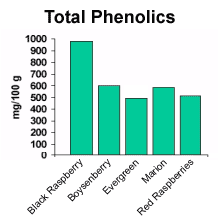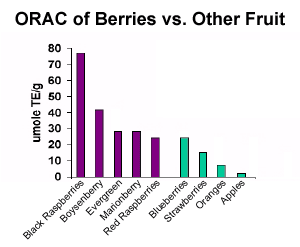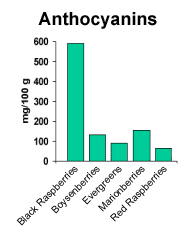|
Antioxidants
by Cat McKenzie
Berry Works News - Fall 2000
Caneberry growers from all across Oregon have reason to smile
today. The good news is in from the 1999-2000 study on the
nutraceutical benefits of caneberries. Conducted with help
from a
$63,000 Federal State Market Improvement grant, the study’s
results
are now complete and have exceeded all expectations. Levels
of
anthocyanins, ellagic acid and total phenolics in caneberries
were
measured and shown to be much higher than previously reported.
Caneberry antioxidants were studied in blackberries, red
raspberries,
Boysenberries, Marionberries and black raspberries. The Oxygen
Radical Absorption Capacity (ORAC), anthocyanin and phenolic
compounds were measured and compared in all berries.
Total Phenolic Values
 All
berries studied showed significant amounts of phenolic and
flavonoid compounds including galllic acid, rutin, isoquercitrin
and ellagic acid. The most widely recognized of these is ellagic
acid, which has been shown to inhibit tumor development and
growth in animals in laboratory studies. The total amount
of ellagic acid was highest in black raspberries, but Boysenberries
were unique in their high concentration of free ellagic acid.
Levels of ellagic acid in all caneberries were higher than
previously reported in scientific literature. All
berries studied showed significant amounts of phenolic and
flavonoid compounds including galllic acid, rutin, isoquercitrin
and ellagic acid. The most widely recognized of these is ellagic
acid, which has been shown to inhibit tumor development and
growth in animals in laboratory studies. The total amount
of ellagic acid was highest in black raspberries, but Boysenberries
were unique in their high concentration of free ellagic acid.
Levels of ellagic acid in all caneberries were higher than
previously reported in scientific literature.
ORAC Value
 ORAC
values measure the degree and length of time a sample of berries
inhibits the action of an oxidizing agent. Antioxidents fight
the spread of free radicals, which can cause cell mutation
and lead to various cancers as well as other diseases of aging.
All listed berries were tested for ORAC value. The results
showed black raspberries at the highest levels having an astounding
77, with Boysenberries at 48, Marionberries and Evergreen
blackberries at 28 and red raspberries at 24. Compared to
other fruits such as blueberries at about 23 and strawberries
at around 12 or oranges and apples both below 5, caneberries
are among the highest fruits in antioxident levels. ORAC
values measure the degree and length of time a sample of berries
inhibits the action of an oxidizing agent. Antioxidents fight
the spread of free radicals, which can cause cell mutation
and lead to various cancers as well as other diseases of aging.
All listed berries were tested for ORAC value. The results
showed black raspberries at the highest levels having an astounding
77, with Boysenberries at 48, Marionberries and Evergreen
blackberries at 28 and red raspberries at 24. Compared to
other fruits such as blueberries at about 23 and strawberries
at around 12 or oranges and apples both below 5, caneberries
are among the highest fruits in antioxident levels.
Anthocyanins
 Also
measured were anthocyanin levels. Anthocyanins fight against
heart disease and age related mental decline. Black raspberries
once again scored the highest with levels reaching 600 mg,
comparable only to chokeberry, bilberry and elderberry. Next
highest were Marionberries approximately 150, Boysenberries
around 125, Evergreen blackberries near 90 and red raspberries
at 50. All caneberries did exceptionally well when compared
to other fruits. Also
measured were anthocyanin levels. Anthocyanins fight against
heart disease and age related mental decline. Black raspberries
once again scored the highest with levels reaching 600 mg,
comparable only to chokeberry, bilberry and elderberry. Next
highest were Marionberries approximately 150, Boysenberries
around 125, Evergreen blackberries near 90 and red raspberries
at 50. All caneberries did exceptionally well when compared
to other fruits.
Very few studies have been done specifically on Marionberries,
Boysenberries and black raspberries. Therefore this study
provides much needed data that shows conclusively that caneberries
are among the highest foods in health enhancing antioxidant
activity and contain significant amounts of phenolics and
anthocyanins. Data collected in the market research phase
of the grant showed that consumer interest in dietary health
is high. The booming nutraceutical and functional food market
is creating ways for very healthy foods such as caneberries
to be used in a multitude of products. This exciting news
provides a basis for new marketing strategies and new avenues
to approach consumers regarding the outstanding benefits of
Oregon berries.
|





